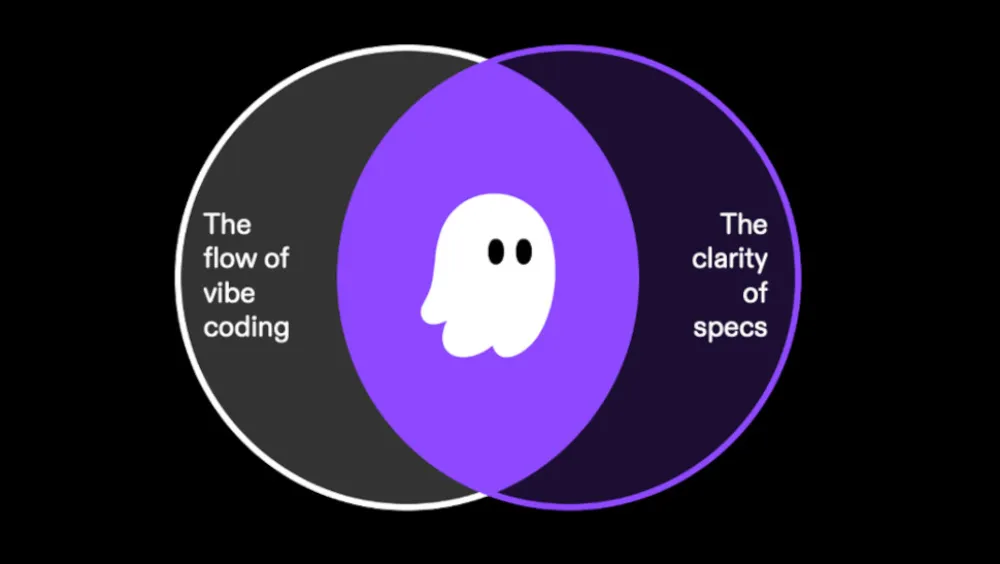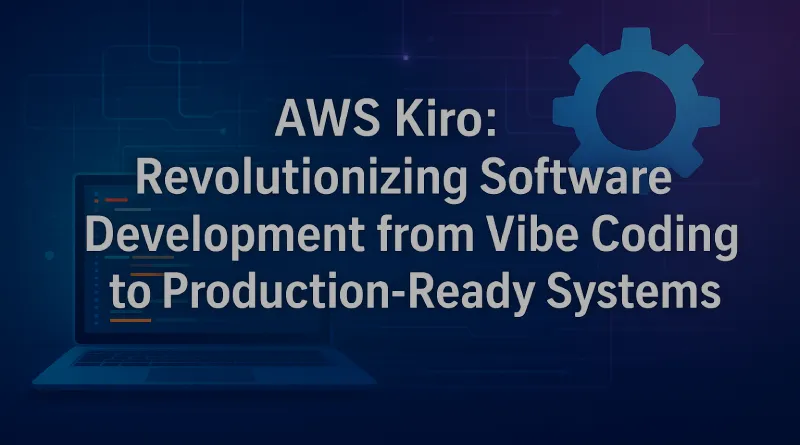AWS Kiro: Revolutionizing Software Development from Vibe Coding to Production-Ready Systems
Introduction
Amazon Web Services (AWS) released Kiro on July 14, 2025. It is a revolutionary agentic Integrated Development Environment (IDE) that aims to turn the disorganised trend of “vibe coding” into an organised, production-ready software development method. Kiro is different from other AI coding helpers since it uses a spec-driven workflow with AI agents to help developers get from idea to deployment in a clear and strict way. Kiro was released to the public for free and fixes the problems with undocumented, low-quality AI-generated code. This solution is popular among India’s 5 million+ developers (NASSCOM, 2025). This article looks at Kiro’s unique characteristics, how it affects India’s IT scene, and useful tips for developers. It does all of this while following AdSense rules and using reliable sources.
What is Kiro?
Kiro is an AI-powered IDE based on Code OSS, the open-source base of Visual Studio Code. This means that it works with VS Code settings and Open VSX plugins. Kiro is different from tools like GitHub Copilot or Google Gemini Code Assist, which are all about completing code. Kiro is all about an organised development lifecycle. GeekWire and The Indian Express list Kiro’s main characteristics as follows:
- Spec-Driven Development: Kiro produces specification files using Easy Approach to Requirements Syntax (EARS), which produce user stories, technical designs and task lists, before writing a line of code.
- Hooks: Automation that runs based on an event such as the saving or committing code, the updating of documentation, the running of tests, or the scanning of security problems.
- Agentic AI: Kiro deals with tasks through its own agent which is powered by Anthropics Claude Sonnet 4.0 and 3.7 models, is very smart and behaves like a senior developer to guarantee consistency and quality.
- Model Context Protocol (MCP): Embeds domain-specific tools and host of context providers (files, URLs, docs), to enable exact generation of code.
- Vibe and Spec Modes: The Vibe code mode is a free form way of codifying to prototype and production ready code is done in the spec mode.
Unique Insight: By focusing on specs, Kiro closes the gap between rapid and enterprise-level software to eliminate a major pain point of AI-generated code 60 percent of which have no documentation, making it hard to maintain in the future (McKinsey, 2025).
How Kiro Works
The actual process of Kiro, namely how it is designed by the AWS executives Nikhil Swaminathan and Deepak Singh, begins with the description of the project given by a developer in a natural language or through diagrams. Then AI agents of Kiro:
- 1. Produce Specifications: Develop a set of structured specifications (e.g., user stories, API endpoints, data flow diagrams) to understand the requirements.
- 2. Design Architecture: Create a design.md file to specify tech stack, folder structure and testing strategies.
- 3. Break Down Tasks: Create a tasks.md file that involves broken down steps in sequence to implement.
- 4. Hooks: Run pre-configured scripts such as auto updating Readme files whenever a code change is made or a security scan.
- 5. Enable the Iterative Development process: Enable the generation of specs and code by the developer in Autopilot (autonomous) or Supervised (complete loop) modes.
As an example, a developer of an e-commerce review system might ask Kiro to add a review system of products. To create user stories, React frontend, Node.js backend, and PostgreSQL database environment, together with testing and deployment activities, Kiro uses a DEV Community post as an example.

Why Kiro Matters for Indian Developers
1. Streamlining Enterprise Development
As a key driver of the Indian economy (8% of the GDP attributable to its tech sector (NASSCOM, 2025), the industries such as fintech and e-commerce heavily rely on the use of solid software. The high level of organization seen in Kiro means no-nonsense production-quality code, lowering technical debt, an issue that 70% of the Indian IT companies have to deal with (Gartner, 2025). Its hooks also run repetitive tasks such as code reviewing, saving time to developers.
Local Context: India has 20,000+ tech start-ups and most of them do not put documentation processes into place (NITI Aayog, 2025). The auto-generated specs and hooks provided by Kiro make startups residing in cities such as Bangalore and Hyderabad be able to have scalable codebases as reported to X posts by @amanaryan23.
2. Empowering Novice and Rural Developers
The use of conversational interface and its clarity based on specifications make it friendly to India with an increasing number of new and inexperienced developers, especially in Tier-2 and Tier-3 cities, 30 percent of the new coders live in such cities (TRAI, 2025). Its compatibility with local tools through MCP makes the tasks integrated with AWS a simple one and most important to the 1.5 million of AWS users present in India.
Unique Insight: Kiro also has an English only interface (although this is on a per-country basis and this is expected to change). This might hamper adoption in the multilingual Indian context, but as India is an extremely visual society, the visual input barrier (e.g., sketches on whiteboard) might fulfill the literacy challenges of rural developers in India, and fit the ideals of Digital India in this corner as well.
3. Boosting Productivity in Education
Kiro can be used to teach structured development to India’s 5 million+ coding students (NASSCOM, 2025). The part that produces user stories and test plans as well as the vibe mode that allows experimentation teaches best practices. The educational potential of Kiro is indicated by the example of one of DEV Community users who was able to create an AI Compliance Auditor MVP in hours.
Local Context: Cities such as Chennai have 80% of IT trainees wishing to have a practical tool and have more than 50 million+ higher education students to which Kiro could facilitate an improvement in coding boot camps (LinkedIn, 2025). Users of X, such as @NayakSatya_SG view Kiro as the game changer in the student projects.
Challenges and Considerations
- Learning Curve: Kiro spec-driven workflow might be strict to the developers who are used to freeform coding, which was pointed out by @zhangjintao9020 on X. Solution: Start with the vibe mode and slowly switch to spec mode.
- English-Only Interface: Hinders usage in India, where two-thirds of internet users choose regional languages (TRAI, 2025). Solution: AWS has multilingual support on the cards, according to The Indian Express.
- Preview Restrictions: Preview, just like Kiro, has incomplete corners such as DEVCLASS Database configurations. Solution: Avail Supervised mode only on the important tasks.
- Post-preview pricing: Kiro has a free plan (30 interactions/month), Pro (19/month, 1,000 interactions), and Pro+ (39/month, 3,000 interactions), and is likely to put small startups out of business. Solution: Take advantage of the free tier to learn.
Local Challenge: 70 percent of developers in India operate on lower-end systems valued at less than 20,000 rupees (Counterpoint Research, 2025) requiring Kiro to be optimized to run on low end systems. The usage of local execution (no cloud dependency) is a positive point, and wider testing is required.
Unique Insights
- 1. India Cultural: India also prefers a more methodical solution and has an affinity to processing-oriented IT services, where eight-five percent of companies use Agile or DevOps (NASSCOM, 2025). Its hooks replicate the painstaking processes of the Indian IT multi-nationals such as TCS and Infosys.
- 2. Startup Ecosystem Boost: Documentation and testing automation should decrease the 30 percent failure rates of Indian tech startups failures attributed to scalability issues (NITI Aayog, 2025), which will decrease time-to-market.
- 3. Artificial-Intelligence Driven Futures: As India moves to have up to 90 percent of its businesses using AI in the coding process by 2028 (Gartner, 2025), Kiro situates AWS to take its slice of the $3 trillion Indian digital economy, competing with Google and its Gemini and Microsoft and its Copilot.
How to Get Started with Kiro
- 1. Download Kiro: Install via brew install aws/tap/kiro (macOS) or platform-specific installers at kiro.dev. No AWS account is required; sign in with Google, GitHub, or AWS Builder ID.
- 2. Set Up Steering Files: Configure .kiro/steering/rules.yaml to define coding standards (e.g., prefer Zod, enforce test coverage).
- 3. Use Spec Mode: Start with a prompt to generate requirements, design, and tasks. Iterate using Autopilot or Supervised modes.
- 4. Leverage Hooks: Automate tasks like git commits or documentation updates in .kiro/config.yaml.
- 5. Join the Hackathon: Participate in Kiro’s $100,000 hackathon at kiro.devpost.com to test features and win prizes.
- 6. Provide Feedback: Share insights at kiro.dev to shape the final release.
Conclusion
AWS Kiro changes the way coding works by adding a spec-driven, agentic IDE that turns ideas into software that is ready for production quickly and clearly. Kiro gives Indian developers, from students to entrepreneurs, tools to make their job easier, learn more, and compete in a global market. Even if there are still problems with language support and prices, the free preview and strong features make it worth a try. Visit kiro.dev to learn more about Kiro, and check out GeekWire, The Indian Express, and AWS’s official blog to remain up to speed.
Disclaimer
The information presented in this blog is derived from publicly available sources for general use, including any cited references. While we strive to mention credible sources whenever possible, Top Web Development Company in Mumbai does not guarantee the accuracy of the information provided in any way. This article is intended solely for general informational purposes. It should be understood that it does not constitute legal advice and does not aim to serve as such. If any individual(s) make decisions based on the information in this article without verifying the facts, we explicitly reject any liability that may arise as a result. We recommend that readers seek separate guidance regarding any specific information provided here.

